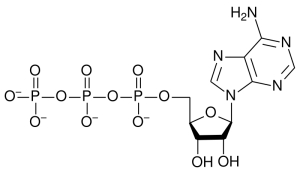Phosphorus is an element critical for life. It is a part of your very genetic make-up in that it forms the framework of DNA and RNA, forms structures with lipids creating phospholipids that make up cell membranes, and of course makes up the majority of adenosine triphosphate, or ATP as you may be more familiar with.
ATP is exactly what it sounds like, a molecule of adenosine with three phosphates attached. ATP is often referred to as the “currency” of cells, as they pass it around as a messenger, taking phosphates from ATP to create adenosine diphosphate (ADP, 2 phosphates) or adenosine monophosphate (AMP, one phosphate), or adding them back as they deem necessary. This is because the chemical process of phosphorylation is key to switching biochemical pathways on and off.
Something that is also important is the ratio in the cell of ATP to AMP in determining energy regulation. At the cellular level, in layman’s, a high ATP ratio suggests a cell in what researchers call the “fed state”, which means that the cell has had its fill of energy from calories. The fed state is what the brain strives to achieve, and is also the state where the body is most conducive of muscle growth and general whole-body anabolism. In these conditions, the brain reduces expression of the hormones that cause you to go looking for food (i.e. hunger and appetite hormones) so that amongst other things, you tend to think a lot less about food.
A high AMP ratio in the cell suggests an energy deficit, which kick starts several biochemical processes informing the brain of the situation. Anabolic processes such as protein synthesis will be halted and fat and glucose will be pulled from their corresponding stores of fat cells and the liver (as well as muscle after prolonged periods of fasting) when necessary, and hunger hormones will be released, causing you to hunt for food. This is all very general, but no doubt you get the idea.
Every time you eat the nutrients are processed and sorted by the liver in one of its many roles in the body. Some of what you eat will be stored or used for repair, but some will also go towards ATP creation in the liver to fulfil immediate energy requirements. It is ultimately the status of the liver ATP levels that tells the brain whether it needs to turn you into hunter mode as it has direct contact with the appetite-control center of the brain.
This is all a rather long introduction to a study conducted at the American University of Beirut in Lebanon. The study, which is due to be published in the International Journal of Obesity, looked at the effect of increasing the phosphorus content of a meal has on satiety. What the researchers aimed to do was essentially trick the brain by increasing liver ATP concentrations by supplying extra phosphorus, but obviously without the calories that come along with eating more food. The concept is both simplistic and clever and amazingly worked. They found that participants tended to eat less in the subsequent meal, indicating lower levels of hunger hormones driving their eating.
While the researchers didn’t look into the actual mechanism behind the effect, it is hypothesized that it is because of increased liver ATP concentrations fooling the brain into thinking energy levels are higher than they are. If you want to try your own experimentation please feel free and be sure to let me know how you get on in the comments box. Obviously don’t go over the top with the dosing though, as too much phosphorus can cause deficiencies in other minerals such as calcium, iron and zinc.
Source: Obeid OA, Dimachkie S, Hlais S. Increased phosphorus content of preload suppresses ad libitum energy intake at subsequent meal. Int J Obes (Lond). 2010 Apr 6. [Epub ahead of print]


Phosphorus supplements for diet (like Phos Fuel from twinlab) were popular many years ago because of studies showing increased metabolic rate and weight loss, but then people found out that the benefits from them were very short lived. I believe there was at least one study that demonstrated the transient nature of the benefits
If only more than 50 people would hear this..